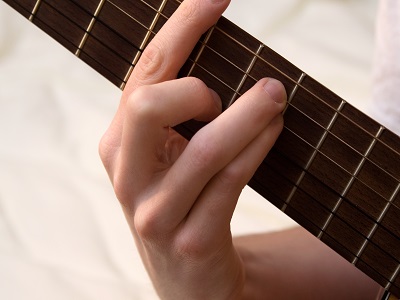Power Chords: The False Chord?
 If a dog dresses like a duck and barks in a mock quack, is it in fact a duck?
If a dog dresses like a duck and barks in a mock quack, is it in fact a duck?
The answer is no, it is not. That doesn’t mean we wouldn’t have use for the duck-dog, though. A dog-duck would be perfectly disguised for riverfront property guarding. Such is the power chord; the chord that isn’t actually a chord, perfectly disguised for use in your music.
What Makes the Power Chord a False Chord?
To put it quite simply, it lacks a third. A power chord is just a perfect fifth and a perfect fourth stacked neatly upon one another. That being said, this not-quite-chord has made a splash in the music scene.
You would be hard-pressed to find a band that doesn’t utilize the power chord as a primary structural tool for both choruses and verses. This isn’t just a pittance, either. As the name suggests, a power chord can be, well, powerful, as it contains an octave, giving it a full-bodied sound.
Making One Isn’t Tough At All
Now that you have a bit of knowledge, let’s create one of these non-chords. If we take a minor and, using A as the root, move up a perfect fifth, we come to E (A#, B, C, C#, D, D#, E).
If we move up a perfect fourth we are left with an octave of A (F, F#, G, G#, A) giving us a minor power chord. All power chords with roots on the low E string or A string will maintain the exact same fingering, making them perfect for easy song structures.
Now that we covered basic knowledge and guitar chord construction, we can get on to the fun part; adding seasoning to your power chords.
If you ate the same thing every single day, eventually, you would become tired of the taste and long for new flavors. The same is true of power chords. Eventually, magic rubs off, leaving behind a less than satisfying monotonous heap of bland writing. With a few added notes, you can revive your beloved power chords in a whole new light.
One Way to Fatten Your Power Chords is to Add Open Notes
Using the example of the minor power chord, by adding an open string that is the fifth of the power chord (E), the chord gains added immensity and grandness. The same can be done with any power chord whose fifth is the same note as an open string (E, A, D, G, B, E).
Another way to prolong the use of your power chords is to add extra fretted notes. Once more using our minor power chord, we can change the entire feel of the chord by simply switching our second A, the octave, to a B. The diatonic interval from the root now becomes a Major sixth, altering our power chord greatly, and giving it a more ethereal sound.
Since power chords are not actually chords, their structures don’t necessarily have to follow set principles. Notes can be added and subtracted, as long as the first diatonic interval remains a perfect fifth, and the chord remains void of a third.
With knowledge of power chords at your disposal, the mastery of pop rock, heavy metal, punk, and so many other genres now lays at the tips of your fingers.







Leave A Comment